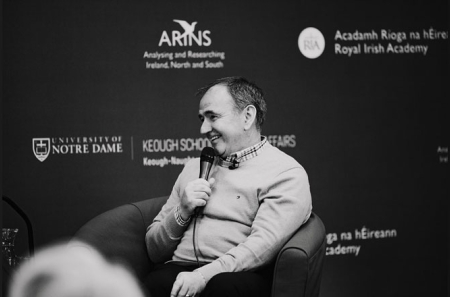
Remembering Identities in Ireland: A Brief History
27 July 2023Thomas Hennessey

As a historian I take a longer view of contemporary events. What many assume to have been eternal is not always so. History reveals there have been identities and structures in Ireland not remembered today. This insight into the past shows us a future way forward.
The question of Irish reunification has long been the goal of nationalist Ireland, both north and south. To be clear we do not see a referendum on the border resulting in a vote for unity anytime soon. But the full implications of Irish unity have recently been addressed in earnest (ARINS, UCL Constitution Unit). For a united Ireland, or ‘New Ireland’, will have to deal with the reality of a million Northern Irish Protestants as a minority in any new state: the same mistakes, in regard to the Catholic minority in the North, with the creation of Northern Ireland in 1921, must not to be repeated. The question is whether Irish nationalism is ready to make some fundamental sacrifices to accommodate the unionists of Northern Ireland in a new state; for a united Ireland will be a new state and a multi-national state, radically different from what the 26 counties is today. What would a New Ireland look like? Are the citizens of the Republic ready to embrace this New Ireland? Will it be an authentic and welcoming place rather than a ‘cold place’ for Unionists.
The Brexit referendum shows the folly of a simple slogan: for ‘Brexit means Brexit’ read Irish unity means Irish unity. Unity does not, necessarily, equate a United Ireland in the traditional sense of one nation state. So, regardless of whether unionists participate in shaping any future Ireland now, it is important that nationalists, North and South, continue preliminary discussions amongst themselves about the kind of New Ireland they are prepared to accept before engaging with Unionists. Nationalists are fully aware of the economic and religious barriers to unity. There is one elephant in the room which ought to form serious consideration: the Britishness of Northern Unionists and how that may be accommodated in a new Ireland.
A nation is an imagined community composed of a narrative its citizens tell one another: those national myths that constitute great shared events. Above all it is a shared consciousness. When Germany was united, after the fall of the Berlin Wall, at least the Germans shared a common sense of national identity, albeit, shaped by the experience of a partition since the Second World War. This is not the case with Ireland and Northern Ireland.
Competing Historical Narratives
On the island of Ireland there are two competing dominant national narratives. The first is the struggle for Irish freedom. This is the nationalist narrative of Irish history. But there is another: the Unionist national narrative. This alternative tale is one of participation in the British state and the British Empire. If one takes one year, 1916, one can see parallel histories and national memories for that year. For Nationalists the primary event was the Easter Rising as part of the struggle for Irish independence. For Unionists, however, 1916 represents the sacrifice of Ulster Protestants, at the Battle of the Somme, for King and Empire: it represents their loyalty to Britain and membership of the British nation state. Same year; different histories.
As powerful as is the Easter Rising for nationalists, in the Irish national story, the Somme is equally as powerful in the psychology of Unionists. The Rising represents the foundation myth of the Irish state; the Somme represents the foundation myth of Northern Ireland. It does not matter that these myths may be full of inaccuracies: it is a reality that large numbers of people believe in them. But the Somme is but one part of this story. Two of the great shared events of Unionism are those, such as the building of the Empire and the participation in the First World War and the Second World War. This was why the nationalist, John Redmond, forced to deal with the reality of Unionist opposition to Home Rule, advocated fighting in the British Army for Ireland and for Home Rule in 1914: to prove to Unionists that Nationalists could also be loyal subjects of the Empire. And it almost worked.
One Irish army officer looked forward, positively, in 1915, to a united Ireland, one in which Irish people could work together. That officer was Captain Sir Basil Brooke, who later, as Lord Brookeborough, became the hard line Prime Minister of Northern Ireland. Following the Easter Rising he no longer described himself as Irish, but as a Britisher or Ulsterman. Sir Edward Carson looked forward, in 1917, to a partitioned Ireland, but a temporary partition, in which the two parts of the island would eventually come together in a united Ireland. It is well to remember the British Government, too, with the Government of Ireland Act 1920, that partitioned the island, looked to a Council of Ireland that would provide the mechanism to vote the two Irish Parliaments out of existence and into one assembly for the whole Ireland. Partition envisaged eventual Irish unity but a united Ireland under the crown.
To understand the unionist sense of dual Irish-British identity we need to recognise that Britishness was once a global identity: one could be British and Irish; British and Scottish; British and Canadian; or British and Australian. To be a British subject one merely had to acknowledge allegiance to the Crown. Now Britishness has shrunk, reduced to an archipelago in the North Atlantic. Perhaps the United Kingdom will break up in the face of Scottish nationalism and the English nationalism of Brexit. Nevertheless, when Unionists now say they are part of a British nation they believe it. Unionists are consistent in defining their identity as Ulster British; British and Northern Irish; or British Irish. The common denominator is British in this multi-layered identity.
This Britishness has been a long time in its creation. Unionist national heroes are Irish, from the Duke of Wellington, at Waterloo, to Sir Alan Brooke (Lord Alanbrooke), Winston Churchill’s military Chief of Staff in World War II. The Unionist identity allows them to be part of great national myths in a British story. Their culture can be local – bonfires on the 11th night and the marching season on 12 July – celebrating their loyalty to the Queen, the Union Flag, to pride in Shakespeare, the Battle of Britain or the sporting success of Northern Irish athletes competing for Great Britain in the London Olympics of 2012. It is unrealistic for this identity to dissipate if there were to be a united Ireland.
All of this is history. What is its relevance now, it may be asked? The present form of nationalism, in independent Ireland, is relatively recent. Prior to the Irish Free State, Irish nationalism operated in a political and cultural environment shaped by 800 years of English and then British involvement in Ireland. It is unrealistic to believe this did not have an impact: it can be seen today from the Royal College of Physicians to the Royal Irish Academy to name but two.
Republicanism took independent Ireland towards a completely new identity dispensation. Republicanism was now part of the public discourse: prior to 1916 – and introduced for the first time in the late 1700s - it was a minority view; Ireland operated for 800 years in a Britannic shaped world. From Daniel O’Connell, through Charles Stewart Parnell, to John Redmond, the only realistic form of government for Ireland was a monarchy within the British imperial framework.
John Redmond, for example, hoped that a new form of Irish nationality, based on the sacrifice of Nationalists and Unionists in the trenches, would form a new Ireland. This was the essence of Home Rule – an Irish national conscious in an overarching Britannic imperial loyalty.
There is evidence of this working among Unionists. Basil Brooke, then a captain in the British Army, looked forward in 1915, to a new political dispensation after the War. But, for Brooke, the Easter Rising was a watershed. From 1916 he never regarded himself as an ‘Irishman’ again, preferring ‘Ulsterman’ or ‘Britisher’ instead to describe his nationality. Sir James Craig, like Brooke a future Northern Ireland Prime Minister, expressed similar views – this time over Ireland’s exclusion from conscription in 1916. The point here is this: that Unionist involvement in the War was central to their sense of psychological participation in the British national project.
In 1911, for example, Arthur Griffith, the founder of Sinn Fein, actually argued for what he termed the creation of a ‘Brito – Hibernian Empire’: he saw an ultimate solution to Ireland’s relationship with Britain as both countries becoming full partners in the imperial enterprise. This was behind his call for Dual Monarchy and the repeal of the Union, to restore the old Kingdom of Ireland: separate kingdoms but the same King. In 1927, Kevin O’Higgins met Sir Edward Carson, in London, and proposed the coronation of the British king, separately, as King of Ireland, in Dublin.
What partition did was to remove having to deal with this Unionist reality, abandoning Northern nationalism, and pursuing the dream of an independent Catholic Gaelic and Republican Ireland for the 26 counties. Independent Ireland turned inwards. Remember that Eamon de Valera, when offered the prospect of a united Ireland in 1940, by Winston Churchill, turned it down because of the sacrifices he would have to make to win Unionist consent. Now no one expects a repudiation of republicanism: but if the dream of Wolfe Tone, to unite Protestant, Roman Catholic and dissenter, in the common name of Irish, is to be realised, some serious thinking as to what that will involve, needs to take place.
Unionist Opposition to Irish Unity
Unionist opposition to Irish unity stems from their Protestantism and the economic link with Britain. Most nationalists recognise this. But opposition to unity also stems from the sense of belonging to a British nation. Nationalists have not recognised the intensity of this, since John Redmond and Home Rule, partly because it challenges the very notion of there being one nation on the island. To admit there might be two national identities on the island suggests partition of some form should exist. Even if one does not accept this two nation argument it should now be possible to recognise Unionist Britishness, as Redmond did, within the language of one nation, two traditions on the island or that of a British heritage. There is scope for a new version of what used to be called a ‘Union of Hearts’.
At the very least Stormont, with power-sharing, should persevere. But the Northern Ireland Protocol demonstrates that a sovereign nation, like the UK, can cede considerable influence over part of its territory to another entity, in this case the European Union. Likewise, the Anglo-Irish Agreement, which preceded the protocol, conceded the right of the Irish government to be consulted, and to put forward policies, for a part of the UK’s territory – the North. It would not take a significant step to imagine unique constitutional arrangements for Ireland to do the same.
The Nation and State Need Not be Co-Terminus
The point is the nation state, while is the dominant political entity now, was not always so. British kings reigned over multiple entities, and were kings of Ireland, Scotland and England – three separate kingdoms and crowns, one person; the Hanoverians who were kings of Great Britain and Ireland and, at the same time, rulers of the Electorate of Brunswick-Lüneburg, part of present day Germany. The Holy Roman Empire, which had existed since 800 AD, until abolished by Napoleon Bonaparte, had hundreds of individual entities governed by kings, princes, dukes, counts, and abbots with an Emperor as its figurehead. Its replacement, the nineteenth century German Confederation, contained an association of 39 German-speaking states plus two great powers, Austria and Prussia, but did not contain all of the Austria Empire nor all of Prussia. The point here is the ability to think creatively about what a New Ireland might be like and it does not have to be a unity state nor merely a federal state. A confederalist, as opposed to a federal, state can be imaginative. It need not be confined to a nineteenth definition of a ‘nation state’.
The simplest model, for an Ireland apart from a unity state, would be a federal Ireland with Stormont retaining its current powers. Unionists, of course, could no longer be unionists: but they would still be loyalists, retaining their longstanding sense of Britishness and allegiance. In a New Ireland, Unionists could constitute a significant minority, perhaps holding the balance of power in the Dáil. This would force the rest of the island to take account of their presence.
Alternatively joint authority could be the form of government if Ireland had sovereignty over the North, post an independence referendum, but chose to administer a shared territory in conjunction with the British government (the reverse could also be true with continuing British sovereignty being exercised over the North). Alternatively, again, joint sovereignty, with both the UK and Ireland, with both countries becoming part of a confederation, could administer Northern Ireland as the intersection between two nations and two cultural identities. This may appear to be a somewhat fanciful notion but the Anglo-Irish Agreement and Northern Ireland Protocol/Windsor Framework have created unique circumstances in administrating part of the British state; and, of course, as we have seen, history provides a number of alternative models.
Unionist Cultural Alienation
Right now unionists are experiencing a siege mentality after a period in which they felt in the ascendency. The confidence of controlling their own destiny, since the Good Friday Agreement and the St Andrews Agreement, has given way to a feeling their identity is under attack in Northern Ireland. There is a process of cultural alienation occurring among the Unionists in the North. They see the advance of their nationalist neighbours, such as increasing prominence of the Irish language, sharing power with nationalists (particularly Sinn Fein), a Nationalist First Minister designate, as part of a cultural and political retreat. A serious situation of political and cultural alienation is developing in the North.
While this may be interpreted as Northern nationalists legitimately demanding their cultural rights, there is a real fear of the deBritishisation of Northern Ireland among Unionists. The North was set up as the ‘Protestant’ part of the island; the fact that it contained one third of its population as Roman Catholic, who did not give their consent to be governed by a Protestant government, made it fundamentally unstable. But, regardless of the rights and wrongs of 50 years of unionist rule/misrule in the region, there is a real concern, a real sense of a long-term erosion, a fear of long-term defeat, particularly since the final Brexit deal. This is not healthy for any society. It was not healthy for Northern society when it affected nationalism in 1921; it is not healthy for Northern, or indeed Irish, society when it affects unionism in 2022.
New Symbols
Recognising the symbolic and cultural Britishness of Unionists may go a long way to acknowledging their place in a potential New Ireland. Northern Ireland could constitute a bridge between Ireland and Britain. As a bare minimum unionists would expect that the guarantees established under the Belfast Agreement would continue to apply to their community in any new dispensation. This would mean the British Irish intergovernmental Council would act as a guarantee to look after Unionist interests. There would continue to be a British Irish Council in which Unionists would participate. The birthright of all the people of Northern Ireland to identify themselves as Irish or British, both, or neither, would continue.
But there ought to be more recognition of this Britishness. Ireland could rejoin the Commonwealth – but, remember, this is no longer a ‘British Commonwealth’, but one composed of independent states, many republics. It is not the British Commonwealth of 1948 when Ireland declared a formal republic. More recognition of the links between Ireland and Britain may be needed. It is interesting to observe that, 1917, Eoin MacNeill was ahead of his time, writing an article that advocated a United Ireland as a republic within the British Commonwealth.
The status of Northern Ireland could be federal and confederal within Ireland and between Britain and Ireland. A British Secretary of State for Northern Ireland could be appointed to be act as a guarantor of Unionist rights. Unionist representation might continue in the British Parliament, but with non-voting rights in the House of Commons/Lords. This would guarantee the continued voice of Unionists in a place where they could air their concerns, and recognise their sense of Britishness. They would not be ‘silenced’ and able to raise any concern for their community in a New Ireland. The Irish Tricolour could continue to be the National Flag of the Irish state; but it could have dual status in Northern Ireland, alongside the Union Jack; or St Patrick’s Cross might be adopted for the North. Or the Tricolour and Union Flag could fly alongside one another rather like the EU flag does, in the Republic, with the Tricolour. Perhaps there could be a completely new National Flag of Ireland incorporating both Irish and British symbolism.
The constitution of Ireland would have to be changed. Irish would no longer be the first language of a New Ireland. Irish and English could be equal and recognised as having ‘equal respect’ for one another as Scots Gaelic and English are in the Scotland Act 2005. And what of Ulster Scots? The heritage of the British community in Ireland could be recognised in the constitution, perhaps given an official status. More than this the right of people to define themselves as part of the Irish nation or part of the British nation (or both/neither) could be enshrined in the Constitution. Perhaps it might better if the right to a British (alongside Irish) cultural heritage were explicitly recognised in the Constitution.
Monuments are considered lieux de memoire or sites of history. They reveal a lot about the dominant narrative in a state. One monument that might be erected in Dublin to replace Nelson’s column, destroyed in 1966 by the IRA, might be Lord Nelson again; or failing such a radical move, a statue of Sir Edward Carson, or Sir Ernest Shackleton the Irish Polar explorer, other prominent Unionists. Unionist ‘heroes’ or Irish soldiers who served in the British Army British-Irish military figures (Lord Roberts VC or Lord Kitchener – a Kerryman) might be appropriate.
Finally, consideration as to whether Amhran na bhFiann, with its talk of the ‘Saxon foe’, remains appropriate for the whole of Ireland: there was controversy when ‘Ireland’s Call’ was played outside the jurisdiction of the Irish state, at Ulster’s rugby ground in Belfast rather than God Save The Queen. This illustrates the sensitivity around all these issues. It ought not be forgotten that most all Ireland sporting bodies are a legacy of pre-partition Unionist Ireland. The conversion of the title of the ‘British Isles’ rugby team to the ‘British and Irish Lions’ illustrates what might be achieved with a little imagination.
None of these suggestions would make the majority of people, on the island, any less Irish than they already feel; nor would it involve surrendering any of their national identity. But it would acknowledge that Irishness is a mature, confident identity secure enough to accommodate other identities. It would surely be wise to start thinking about this now. The important question to ask is does one want to unite territory or to unite people, to borrow from John Hume? It means that a New Ireland ought to recognise its British, as well as its Irish, heritage.
Thomas Hennessey is Professor of Modern British and Irish History at Canterbury Christ Church University.



